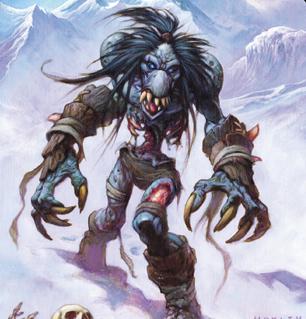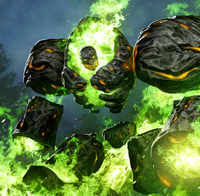Death Knight, Variant (4e Paragon Path)

|
|---|
Death Knight[edit]
| “ | Fallen Knights, no longer among the living, but masters of the undead. | ” |
Prerequisite: Paladin, Level 11, Lay on Hands, Must worship at least one unaligned or evil god
Paladins who turn to the path of Darkness are often corrupted in some ways. While they are not always evil per se, many of them realize that worshiping more darkly inclined Gods is an unfortunate necessity. While still divinely inspired, it is often more so by dark and chaotic forces, that preach pragmatism and practicality rather than the Paladin's more typical code of ethics. Death Knights tend to be more willing to accept what they see as unfortunate or necessary evils when trying to achieve their goals, being Authoritarian or willing to go to extremes. They have a tendency to float around Chaotic Good or Lawful Evil, believing in their cause but willing to do terrible things to achieve their results. This could include killing prisoners, torture or even Mass Murder, all in the name of Justice. Not all Death Knight Paladins are necessarily evil or do immoral things, but they have made a sacrifice in order to gain power in return, being inherently corrupted. Death Knights tend to behave differently after their initiation, being more ruthless or cruel, or being far darker.
Death Knight Path Features[edit]
- Undead Body (11th Level): The character is considered an undead creature for the purpose of effects that relate to the undead keyword. You are also considered a living creature in addition to your previous features. You do not need to eat, drink, sleep, or breathe.
- Unholy Strength (11th Level): All of your attacks can deal necrotic and cold damage, in addition to their previous type.
- Death's Mastery (11th Level): Whenever you spend an action point, you gain temporary hitpints equal to your wisdom modifier.
- Death's Embrace (16th Level): You can use your lay on hands ability interchangeably with "Death's Embrace". Each use of the "Death's Embrace" power counts towards your daily lay on hands limit, which is equal to your wisdom modifier. The power allows you to deal damage equal to your healing surge value.
Death Knight Minions[edit]
Minions of the Death Knight. These minions have their health based on a Fraction of the Death Knight's, and do damage based on their ability modifiers. Their defenses and skill bonuses also improve by the Death Knight's, or 1/2 the Death Knight's level. Minions can take actions independently of the Paladin, including attacking targets. In this way, a minion can add their attack as extra damage to the Paladin's. However, the damage is generally very low, and on par with other paragon path abilities (Such as The Fighter's Pit Fighter or Mercykiller). The damage done by the Zombie is 1D8 per attack, and doubles to 2d8 at level 21. Minions regain hitpoints by using the Death Knight's healing surges. When a minion could otherwise spend a healing surge, it instead uses the Death Knight's healing surges and heals by their healing surge value. A minion can be dismissed as a free action.
Zombie[edit]
Zombies deal 1d8 damage on a successful hit with an attack. However, Zombie movements, attacks and actions do not count against the Death Knight's, so you can deal 1d8 damage in addition to the paladin's attacks, or even attack separate creatures. Zombies attack with the Death Knight's Strength ability modifier, rather than their own. However, Zombie's roll skills using their own attributes. The zombie's damage increases to 2D8 at level 21.

|
|---|
Infernal[edit]Infernals do 2D10 damage + Strength. In addition, Infernal's movements, attacks and actions do not count against the Death Knight's, so you can add the 2D10 + Strength as bonus damage to your attack rolls, or even attack separate creatures. Infernals attack with the Death Knight's Strength ability modifier, and use the Death Knights Strength when determining damage with their attacks, rather than their own. However, Infernals roll skills using their own attributes. In addition, every creature the Infernal targets with an attack is marked until the end of your next turn, and takes a -2 penalty to attack rolls that don't include the Paladin or the Infernal as a target.
|
||||||||||||||||||||||||||||||||||||||||||||||||||||||||||||||||||||||||||||||||||||||||||||||||||||||||||||||||||||||||||||||||||||||||||||||||||||||||||||||||||||||||||||||||||||||||||||||||||||||||
